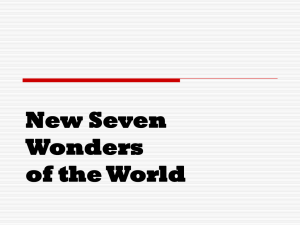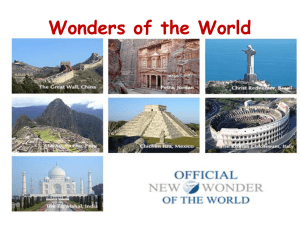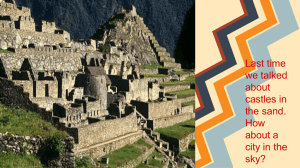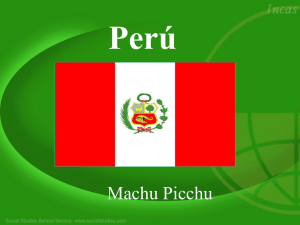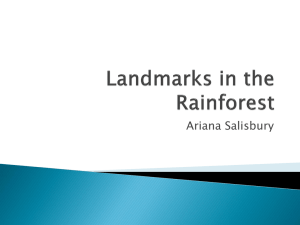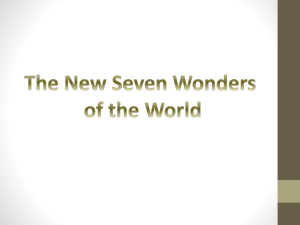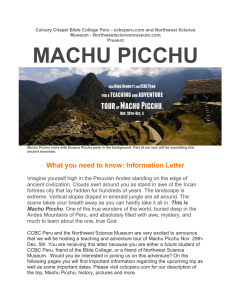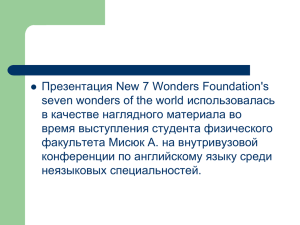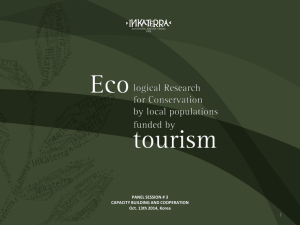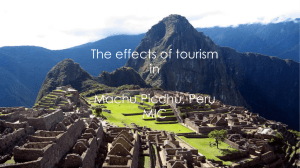File - Katie Pardee
advertisement
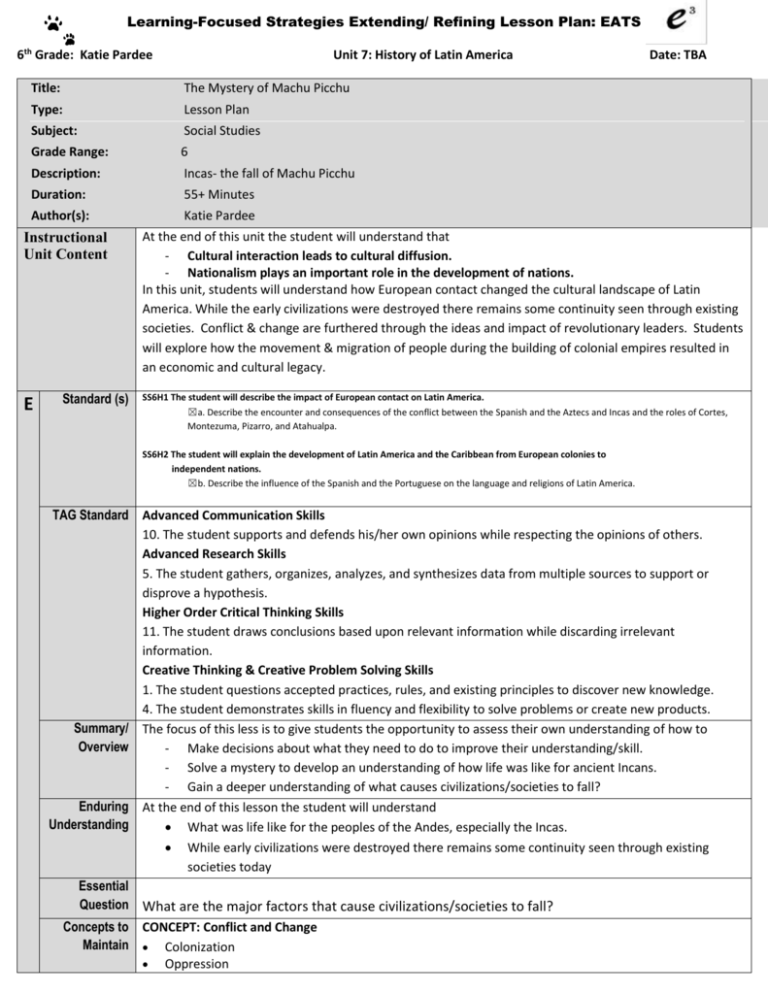
Learning-Focused Strategies Extending/ Refining Lesson Plan: EATS 6th Grade: Katie Pardee Unit 7: History of Latin America Title: The Mystery of Machu Picchu Type: Lesson Plan Subject: Social Studies Grade Range: 6 Description: Incas- the fall of Machu Picchu Duration: 55+ Minutes Author(s): Katie Pardee Instructional Unit Content E Standard (s) Date: TBA At the end of this unit the student will understand that - Cultural interaction leads to cultural diffusion. - Nationalism plays an important role in the development of nations. In this unit, students will understand how European contact changed the cultural landscape of Latin America. While the early civilizations were destroyed there remains some continuity seen through existing societies. Conflict & change are furthered through the ideas and impact of revolutionary leaders. Students will explore how the movement & migration of people during the building of colonial empires resulted in an economic and cultural legacy. SS6H1 The student will describe the impact of European contact on Latin America. ☒a. Describe the encounter and consequences of the conflict between the Spanish and the Aztecs and Incas and the roles of Cortes, Montezuma, Pizarro, and Atahualpa. SS6H2 The student will explain the development of Latin America and the Caribbean from European colonies to independent nations. ☒b. Describe the influence of the Spanish and the Portuguese on the language and religions of Latin America. TAG Standard Advanced Communication Skills 10. The student supports and defends his/her own opinions while respecting the opinions of others. Advanced Research Skills 5. The student gathers, organizes, analyzes, and synthesizes data from multiple sources to support or disprove a hypothesis. Higher Order Critical Thinking Skills 11. The student draws conclusions based upon relevant information while discarding irrelevant information. Creative Thinking & Creative Problem Solving Skills 1. The student questions accepted practices, rules, and existing principles to discover new knowledge. 4. The student demonstrates skills in fluency and flexibility to solve problems or create new products. Summary/ The focus of this less is to give students the opportunity to assess their own understanding of how to Overview - Make decisions about what they need to do to improve their understanding/skill. - Solve a mystery to develop an understanding of how life was like for ancient Incans. - Gain a deeper understanding of what causes civilizations/societies to fall? Enduring At the end of this lesson the student will understand Understanding What was life like for the peoples of the Andes, especially the Incas. While early civilizations were destroyed there remains some continuity seen through existing societies today Essential Question What are the major factors that cause civilizations/societies to fall? Concepts to CONCEPT: Conflict and Change Maintain Colonization Oppression Warfare Religion Civilization Power Struggle Evidence of What students should know: Learning a. What civilization Machu Picchu a part of? And to a greater extent, what happened to the entire civilization (not just those as Machu Picchu) b. What was left behind by the Incas at Machu Picchu that remain today and that can be seen having an impact on existing societies What students should be able to do a. Develop a hypothesis of what happened to Machu Picchu b. Use that hypothesis to infer what makes civilizations/societies fall Suggested Vocabulary Machu Picchu, Hiram Bingham, Inca, Andes, Stone work, mummies, kings, PROCEDURES A T PHASE 1: Hook/ Activating Strategy Teaching STRATEGIES: ☐ KWL ☐ Wordsplash ☒ Draw Pic/Diagram ☐ Brainstorm ☐ Draw Pic/Diagram ☐ Anticipation Guide ☐ Activating Acrostic ☐ Dear Teacher ☐ Sponge ☐ Other: Details of Activator: Teacher will post a picture of a mysterious city on top of a side of a mountain. The students will not have any background knowledge of the picture or coin. Questions to ask: Can anyone identify the figure on this location? What is it? Does anyone have a guestimate of when this location might have been created? Has anyone seen it before? If, so where? Discuss with class. ☐ Peer Tutoring ☐ Simulations ☐ Hands On ☐ Lecture ☐Independent Activities ☐ Cooperative Learning ☐ Visuals ☐ Graphic Organizers ☐ Pairings ☐ Centers ☐ Whole group instruction ☐ Projects ☐ Technology Integration ☐ Guided Reading ☐ Response Cards ☐ Gallery Walk ☐ Quick Write ☒ Other: Details of Strategies: Mystery – solve a mystery to explore students’ ideas of what life was like for the Incas and how a society can collapse. Differentiation STRATEGIES: ☐ Anchor Activities ☐ Choices of Review ☒ Flexible grouping/ seating ☐ Simulations ☐ Games ☐ Centers ☐ Centers ☐ Lit Circles ☐ Cubing ☐ Menus/ Choice Boards ☒ Multiple levels of questions ☐ Think-Pair- Share ☐ Interest Groups ☐ Multiple Intelligence ☐ Jigsaw ☐ Varied Modes of Products ☒ OTHER: Mystery Students will be grouped based on their learning styles founded at the start of the year. The groups should be no more than four . There will be a range of ability levels in each group. Multiple levels of questions will be asked throughout the lesson. Rigor & Relevance ☐ A ☐B ☒C ☐D Level of DOK PHASE 2/3: Examine the Content/ Synthesis Activity ☐1 ☐ 2 ☒3 ☐4 2: Examine the Content Share the Mystery Distribute the “The Mystery of Machu Picchu,” adapted from PBS Ghosts of Machu Picchu. Students read the mystery independently. “You are now going to be broken up into groups to solve the mystery of Machu Picchu. What do you think happened to the people of Machu Picchu? Why did they abandon their city? How were the Incas involved?” Share the Clues Students are broken up into range of ability levels groups. Students will read and then cut the clues out. You will not give the students the categories for the clues. You will need to have students create categories based on the clues that they have cut out. You may give one example: “Category like: Religion”. Make sure students know that they are working together to sort the clues in the appropriate categories. Let students know that they will be using butcher paper to explain their categories and thinking. Students need to write a title for their categories and glue the clues underneath the categories that they created. You will also write a few sentences explaining why you put the clues in the groups you did and why you gave the groups the specific titles. You will need to write a theory and provide two pieces of textual evidence from the clues in regard to what you and your group believed happened to Machu Picchu. Share Solutions and Hypotheses/Discussion Once the posters are completed, students will complete a gallery walk to review the groups’ solutions and hypothesis for the mystery. We will then discuss. “Based on the evidence, why do you think happened to Machu Picchu?” 3: Synthesis Activity. Each group will write a newspaper article explaining the abandonment of Machu Picchu by the Incas. Students will be required to provide evidence from their learned through gathering and analyzing their clues. Students need to make sure that they have as many pieces of evidence to support their claims when writing their articles. The minimum amount is 5 clues. The more evidence the students have in their letter, the better they will be. Class Discussion: What would cause a civilization like the Inca’s to abandon one of their cities? Why do civilizations collapse or decline? S Summarizing STRATIGIES ☐ Answer EQ ☐ Hand Signals ☐ Journal Entry ☒ TOTD ☐ ABC Summary ☐ Oral Questioning ☐ One Minute Essay ☐ Index Card Summary ☒ Other: Sum – It – Up! ☐ Debriefing Details of the Summarizer (What are students doing?): Students will complete a Tick Out the Door answering the following questions. - After investigating, why do you think Incans abandoned Machu Picchu? Explain your thinking. - What would cause a civilization to collapse? *Next day watch PBS special- Ghosts of Machu Picchu Resources Resource(s): http://www.carnegiemuseums.org/cmag/bk_issue/2003/sepoct/feature1.html http://www.pbs.org/wgbh/nova/ancient/ghosts-machu-picchu.html Anchor Text(s): (Students are doing the summarizing) Technology: http://www.pbs.org/wgbh/nova/ancient/ghosts-machu-picchu.html Handouts: Handout 1: Hook picture Handout 2:“The Mystery of Machu Picchu,” adapted from PBS “Ghosts of Machu Picchu” Handout 3: Clues Handout Handout 4: Newspaper Article, “Machu Picchu Explained!” Handout 5: Sum it up Handout 1 Hook: Handout 2: Mystery of Machu Picchu The Mystery of Machu Picchu High in the Peruvian Andes, there's an ancient city called Machu Picchu. It is a ruin that defies explanation. Who were the mysterious people who built it and why did they build it here? With no defensive wall, it doesn't look like a fortress. Instead, there are fountains and small pools, temples and strange altars cut from granite, but little else to explain how a people who didn't have iron tools or the wheel could have created such a masterpiece and why... Perched at 8,000 feet on a narrow ridge in the high Andes, Machu Picchu is a remote and mysterious ancient wonder. Spread across the top of this ridge are more than 200 structures, each built with exquisitely cut stone. Some appear to be homes, others temples. They surround a one-acre green, and all are fed by open waterways and fountains. It is a lost city, whose doorways and passages hint at the ghosts of its past; a place that is at once beautiful and baffling. There are no written clues in the city, no carvings to suggest a purpose. At its highest point, the mystery only deepens. There, a beautifully carved pillar stands, a graceful riddle to cap the site. From this lofty height, the views leave one stunned, but also curious. How did the builders get all this stone up here and then cut it so finely that they didn't even need mortar to hold their walls in place? Who built Machu Picchu? And why did they build it in this impossible place? Throughout the city, stones seemed to be on the verge of being placed when work came to a stop. Even more perplexing, why did they abandon it? Mystery is adapted from PBS Special: Ghosts of Machu Picchu http://www.pbs.org/wgbh/nova/ancient/ghosts-machu-picchu.html Handout #3- Clues Looking at the remains of those left behind, VALERIE ANDRUSHKO (Southern Connecticut State University) stated, “To me, this is the type of injury more indicative of a weapon, possibly of warfare.” There are clues far below the city and underneath it and in the stories of the mummies of kings. Fernando Astete, director of the Machu Picchu Archaeological Park. FERNANDO ASTETE (Machu Picchu Archeological Park/Translation):There is such an important cultural legacy here, not just for Peruvians, but a legacy for the entire world.The Path to Machu Picchu was built by people who were sure-footed, with little fear of heights: The Incas. Inca rose to power in the mid-1400s in part because they built such good roads. Much of their 10,000-mile network is still visible today. Inca left other evidence that they were master engineers and builders. Their terraces, canals and stone cities rival those of ancient Rome. But unlike the ancient Romans, they did all of this without the wheel, without iron and without a written language. The Inca did have a calculating system, using knotted strings called khipu, but it left no record of their lives or their history. So, much of what we do know comes from the Spanish who conquered them in the 1500s. These accounts carry the bias of conquerors. A different view comes from an Inca artist named Guaman Poma. Poma was born shortly after the Spanish arrived in Peru, so he was an observer who bridged both worlds. He produced hundreds of simple drawings about farming techniques, royalty and the Inca history of conquest.From both these sources, we know the Inca were fierce warriors who subjugated dozens of different peoples, forging them into one of the largest empires in the world, stretching some 2,400 miles. Inca fed their people by transforming steep slopes into farmland with the rise and run of terracing. It's believed that more land was under cultivation during Inca times than is today in modern Peru. But the most surprising detail about the Inca is that they ruled for only 100 years. Then, their empire was decimated, first by disease, then civil war, finally the Spanish Conquistadors. From the Spanish, we know that the last Inca emperor retreated into the mountains, to a city called Vilcabamba. The Inca held out at Vilcabamba for 35 years, until, finally, in 1572, the Spanish destroyed the city. Strangely, they left no written record of where it was located, and the legend of the lost city of Vilcabamba was born.It was a mystery that had powerful allure. Almost 350 years later, it pulled an American explorer named Hiram Bingham here on a quest to find it. On the morning of July 24, 1911, Bingham, camera at the ready, reached the top of a ridge and stepped into history."It fairly took my breath away," he later wrote. Bingham's photos marked one of the first times that a moment of discovery had been captured on film. Today, those pictures are part of a rare 23-volume explorer's album detailing Bingham's discovery. Bingham called it by its local name, Machu Picchu, but he thought it was the lost city of Vilcabamba. A year later, when his team discovered over 100 burials, Bingham believed he'd found the evidence to make his case.After thorough examination, Bingham and his bone expert, Dr. George Eaton, reached an astonishing conclusion: 80 percent of the dead were women. Was Machu Picchu a military fortress or was it a religious center? The answer can perhaps be found in the ancient capital of Cusco, where the descendants of the Inca still live. Every year, during the Roman Catholic festival of Corpus Christi, statues of the Virgin Mary, along with 15 other saints, are removed from the cathedral and brought to the square. These performers may be paying homage to Christian saints, but the instruments they play and the steps they move to are actually Inca in origin. That's because this Corpus Christi procession is a Christian revision of an Inca ritual. Five hundred years ago, the Inca also processed through Cusco, but they didn't carry statues of saints. They carried the mummies of their kings, whom they revered as gods.It was likely one of these kings who built Machu Picchu. The quality of the stonework alone suggests the city was royal. Fernando Astete estimates that it would have taken at least 50 years to complete. Since the Inca Empire only lasted 100 years, focus has been on the earliest kings. The accounts of a Spanish Jesuit named Bernabé Cobo point to a dynamic leader who founded the Inca Empire, a king named Pachacuti. But no one could ever prove that Pachacuti built Machu Picchu.A small clue was hidden in his name, which means, "He who remakes the world." What we know of Pachacuti's history is due in part to Father Cobo. Cobo arrived in Peru after the conquest in the late 1500s and wrote his account based on interviews with descendants of the Inca. According to Father Cobo, Pachacuti was renowned as a builder. Handout #4 Name:______________________________________________________ Date:______________ Period:__________ Extra Extra Read All About It: Machu Picchu Explained! Directions: You will be writing a newspaper article explaining that you have solved the mystery to what happened to the ancient Incan city of Machu Picchu. In your article, you need to refer to at least five of the clues that you categorized earlier as evidence for your discovery. You need to make sure that your letter is well thought out and that you have correct punctuation, grammar, etc. __________________________________________________________________________________________________________ __________________________________________________________________________________________________________ __________________________________________________________________________________________________________ __________________________________________________________________________________________________________ __________________________________________________________________________________________________________ __________________________________________________________________________________________________________ __________________________________________________________________________________________________________ __________________________________________________________________________________________________________ __________________________________________________________________________________________________________ __________________________________________________________________________________________________________ __________________________________________________________________________________________________________ __________________________________________________________________________________________________________ __________________________________________________________________________________________________________ __________________________________________________________________________________________________________ __________________________________________________________________________________________________________ __________________________________________________________________________________________________________ __________________________________________________________________________________________________________ __________________________________________________________________________________________________________ __________________________________________________________________________________________________________ __________________________________________________________________________________________________________ Handout #5- Sum it Up Name: _________________________________________________________ Date:_______________ Period:_____________ Sum It Up! Considering what you learned today about the Incas, what do you think would cause them to abandon their city of Machu Picchu? Explain why with evidence from your learning. Extension: Illustrate your response. Answer the Essential Question: What are the major factors that cause civilizations/societies to fall?
